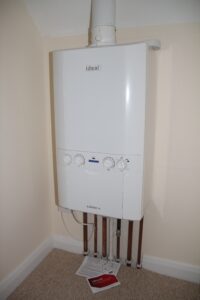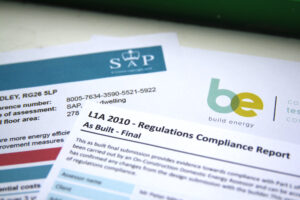What effect does my fuel choice have on SAP compliance? Can I pass with electric heating? We aim to answer these questions and more in this 3 part technical series.
The headline compliance targets in Part L1a of the building regs are based on carbon emissions – that is achieving a DER (Dwelling Emission Rate) equal to or lower than the TER (Target Emission Rate).
The fuel type you use to provide your hot water and space heating will affect your dwellings’ emissions, so if you use electricity or oil to provide your space and/or water heating, you’ll be increasing the emissions of the heating compared to if you used gas.
The target emissions in SAP are based on a gas system. Oil has 1.38x the emissions of gas, so using oil will increase your heating related emissions (the majority of the emissions in SAP) by 1.38x.
Electricity has 2.40x the emissions of gas, so if you use electricity for all of your heating then your dwellings’ emissions for heating will be around double compared to using gas boilers. Electric heaters are 100% efficient in SAP, whereas gas boilers are around 90% efficient, so the higher efficiency for electric heating means its emissions will be more like 2.16x the emissions of gas.
So does using electric or oil make it harder to pass?
Yes. However, you don’t have to compensate for all the additional emissions you’ve created. When SAP calculates the target (TER), it assumes gas heating is used, but then applies a ‘fuel factor’ to the heating related emissions, increasing them. The fuel factor is based on the fuel types associated with the space and water heating, and for most fuels that have higher emissions than gas (electricity, oil, LPG), the fuel factor is greater than 1. This increases the heating emissions in the TER, and therefore increases the total TER, making it easier to pass.
 It’s important to remember that the fuel factor does not cover all of the additional emissions. For electricity, we said that the heating emissions increase by 2.4x, but the fuel factor only increases the heating emissions in the TER by 1.55x, so you will still need additional emission-saving measures in order to meet compliance.
It’s important to remember that the fuel factor does not cover all of the additional emissions. For electricity, we said that the heating emissions increase by 2.4x, but the fuel factor only increases the heating emissions in the TER by 1.55x, so you will still need additional emission-saving measures in order to meet compliance.
For major schemes in London that need to show at least a 35% reduction emissions through on-site measures, the TER is always based on using gas as the fuel with no fuel factor helping you. So if you were to use electric heating you have the whole of the 2.4x increased emissions to compensate for.
|
Fuel |
Emissions kgCO2 per kWh[1] |
Fuel Factor[2] |
|
Mains Gas |
0.216 |
1.00 |
|
Electricity |
0.519 |
1.55 |
|
LPG |
0.241 |
1.06 |
|
Heating oil |
0.298 |
1.17 |
|
Wood logs |
0.019 |
1.00 |
|
Wood pellets |
0.039 |
1.00 |
|
Dual fuel appliance (mineral and wood) |
0.226 |
1.00 |
[1] Table 12 in SAP 2012: The Government’s Standard Assessment Procedure for Energy Rating of Dwellings
[2] Table 1 in L1A Conservation of Fuel and Power in New Dwellings 2013
